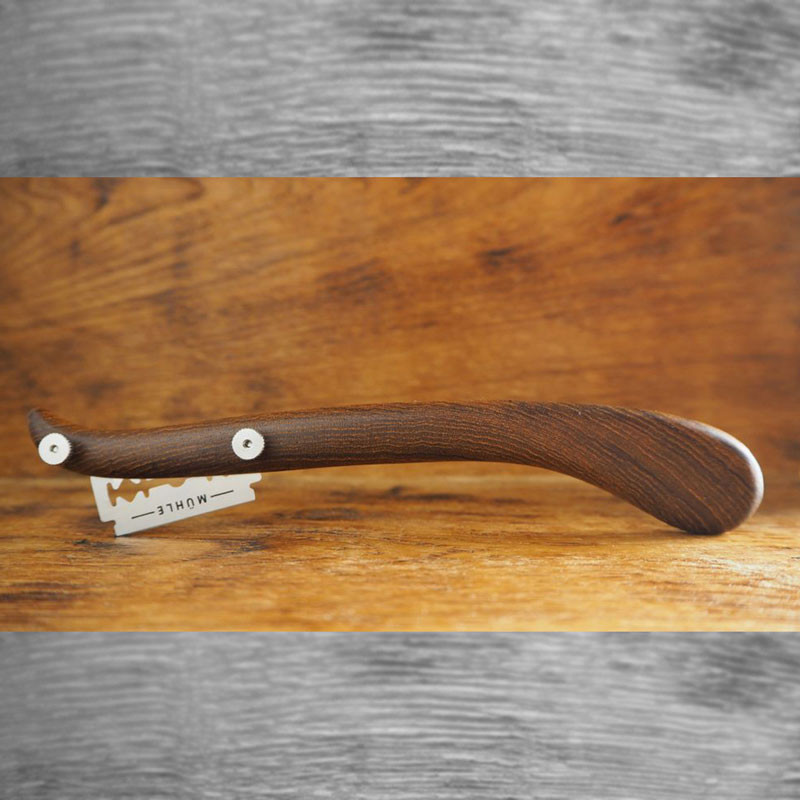

Order by 4 pm = delivery the next working day.
From CHF 100 purchase




Caution sharp! Keep out of reach of children.
Cut your dough quickly and precisely with this fine handmade baker's knife or lame de boulanger. When baking, the cut is torn open further and a beautiful pattern is created as well as a crispy and finely chipped crust. The fine wooden handle fits comfortably in your hand, and the blade can be easily replaced. Each knife is lovingly handcrafted, the grain of the wood may vary from the picture.
Data sheet
Bread fresh from the baker is good, a self-kneaded and baked in your own oven is better. For passionate bakers such a noble baker's knife is a wonderful working utensil, which is both beautiful and practical. The wooden handle is lovingly handcrafted beautifully shaped and smoothly ground, so it is particularly nice in the hand. The blade can be easily replaced, with the baguette blade insert, the knife can be used with a curved blade. The blades of a professional pastry knife are ground extra sharp, ensuring precise and deep cuts without the dough warping or sticking to it. This fine knife comes with a blade guard, blade and cotton pouch.
The appropriate cutting technique varies greatly from bread dough to bread dough. How a bread should be cut is determined by many different factors such as the amount of liquid and flour, the intensity and timing of kneading, the baking process, and of course the desired appearance. Always pay attention to the remarks in the instructions, most bread recipes indicate which cut corresponds to the bread.
For a simple diamond pattern, a cross or the typical diagonal incisions, you can use the knife with a straight blade. To do this, simply clamp the blade in the handle using the screws. Shape the bread dough and let it rise again a little covered with a pastry plastic or a dough cloth. Depending on the type of bread and the desired pattern, flour the dough well. This is typical with diamond patterns and also looks great with crosses, simple diagonal cuts look great without a floured crust. A sieve should be used for flouring, otherwise unsightly flour spots will appear, and in other places the bread will shimmer through. Then take a baker's knife to hand and keep it nice and straight. Now you can cut your bread with the front corner of the blade in the desired pattern. If the dough is a little soft and gets warped easily, you can hold it in shape a bit with your other hand. Make sure to make deep enough cuts so that they can tear open nicely afterwards.
Curved knives or baguette blades are particularly suitable for a baguette. This is because the typical diagonal cuts are applied much flatter than the cuts mentioned above. To do this, remove the razor blade and insert a baguette insert. Tighten the screws until the insert holds. Then bend the razor blade slightly and insert it onto the insert so that the blade conforms to the bend of the insert. You can find an instruction video on how to insert the blade here . Hold the knife slightly tilted sideways over the fully proofed dough. Now cut as parallel as possible diagonals, the dough should be superficially cut the skin. In contrast to the above technique, the cuts here will not separate while the dough is still rising. The cut flaps of dough will lay flat again on the baguette and cover the cut somewhat. Only during baking do they tear open nicely and thus remain relatively smooth.
Of course, special swirl or floral patterns are particularly beautiful. These you can either cut a little wild and jumbled or very evenly and orderly. First, flour the bread and spread the flour by hand on the dough piece. For a perfect flower, first take a thread to hand, with which you visually first quarter and then eighth the bread on the flour. Now, at each stroke, place the knife in the middle where the lines meet. Then you pull the knife outward in a slight arc, ready is the cut back on the line. This step is repeated on the other side of the line. Proceed in this way for every other line. Now you should see a four-petaled flower. Then place the knife in half of a petal and draw it outward in an arc onto a line you haven't used yet. Again, repeat this on both sides of every other line. This creates a great eight-petaled flower.

Caution sharp! Keep out of reach of children.
Cut your dough quickly and precisely with this fine handmade baker's knife or lame de boulanger. When baking, the cut is torn open further and a beautiful pattern is created as well as a crispy and finely chipped crust. The fine wooden handle fits comfortably in your hand, and the blade can be easily replaced. Each knife is lovingly handcrafted, the grain of the wood may vary from the picture.